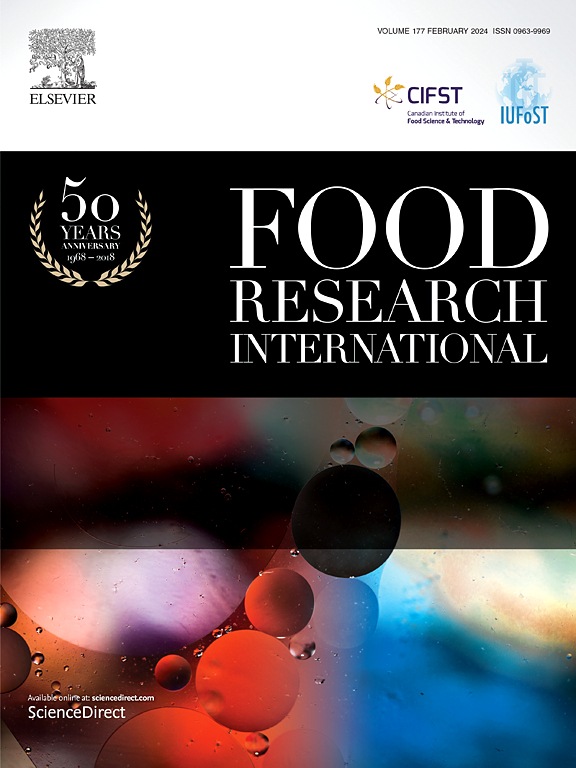Insights into viscosity, rheology, microstructure, and in vitro digestibility of Cyperus esculentus starch-Sanxan Gum mixtures
IF 8
1区 农林科学
Q1 FOOD SCIENCE & TECHNOLOGY
引用次数: 0
Abstract
Hydrocolloids are effective in modulating the processing characteristics of native starches, with their efficacy depending on the structural properties of the colloid. This study focused on the effects of different Sanxan gum (SG) concentrations on multiple dimensions of Cyperus esculentus starch (CES), including viscosity, rheology, structural properties, and in vitro digestibility. Viscosity results indicated that SG reduced the peak temperature (70.60–69.07 °C), peak viscosity (372.50–346.69 BU), and breakdown value (89.00–23.00 BU) of CES gels, while increasing the setback value (220.00–232.33 BU), with this effect becoming increasingly pronounced at higher SG concentration. The rheological experiments further revealed that the addition of SG reduced the apparent viscosity, storage modulus (G′), and loss modulus (G″) of the CES, and this trend gradually weakened with increasing SG concentration, showing a clear concentration-dependent relationship. The textural analysis showed a progressive increase in hardness from 16.55 g to 26.70 g. SEM results exhibited network formation; at low SG levels, the mixtures showed irregular voids, while high SG levels yielded homogeneous and dense networks. This morphological evolution was critical for enhancing the structural stability and processing properties of the CES. In addition, the in vitro digestibility of CES was significantly reduced by the addition of SG, which improved its nutritional and functional properties (RDS 79.11 %–71.08 %, SDS 5.85 %–6.82 %, RS 15.04 %–22.10 %). This study not only elucidates the potential interaction mechanism between SG and CES, but also lays a theoretical foundation for broadening the application of CES.

塞柏淀粉-三散胶混合物的粘度、流变性、微观结构和体外消化率的研究
水胶体在调节天然淀粉的加工特性方面是有效的,其功效取决于胶体的结构特性。本研究主要研究了不同浓度的三散胶(SG)对莎草淀粉(CES)黏度、流变性、结构特性和体外消化率等多个维度的影响。黏度结果表明,SG降低了CES凝胶的峰值温度(70.60 ~ 69.07℃)、峰值黏度(372.50 ~ 346.69 BU)和击穿值(89.00 ~ 23.00 BU),增加了挫折值(220.00 ~ 232.33 BU),且随着SG浓度的增加,这种作用越来越明显。流变学实验进一步表明,SG的加入降低了CES的表观粘度、储存模量(G′)和损失模量(G″),且随着SG浓度的增加,这一趋势逐渐减弱,呈现出明显的浓度依赖关系。织构分析表明,硬度从16.55 g逐渐增加到26.70 g。SEM结果显示网状结构;在低SG水平下,混合物呈现不规则的空洞,而高SG水平下,混合物呈现均匀而致密的网络。这种形态的演变对提高CES的结构稳定性和加工性能至关重要。此外,SG的添加显著降低了CES的体外消化率,提高了其营养和功能特性(RDS为79.9% ~ 71.08%,SDS为5.85% ~ 6.82%,RS为15.04% ~ 22.10%)。本研究不仅阐明了SG与CES之间潜在的相互作用机制,而且为拓展CES的应用奠定了理论基础。
本文章由计算机程序翻译,如有差异,请以英文原文为准。
求助全文
约1分钟内获得全文
求助全文
来源期刊

Food Research International
工程技术-食品科技
CiteScore
12.50
自引率
7.40%
发文量
1183
审稿时长
79 days
期刊介绍:
Food Research International serves as a rapid dissemination platform for significant and impactful research in food science, technology, engineering, and nutrition. The journal focuses on publishing novel, high-quality, and high-impact review papers, original research papers, and letters to the editors across various disciplines in the science and technology of food. Additionally, it follows a policy of publishing special issues on topical and emergent subjects in food research or related areas. Selected, peer-reviewed papers from scientific meetings, workshops, and conferences on the science, technology, and engineering of foods are also featured in special issues.
 求助内容:
求助内容: 应助结果提醒方式:
应助结果提醒方式:


